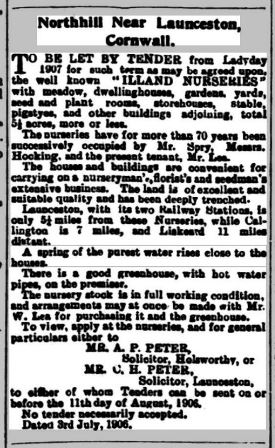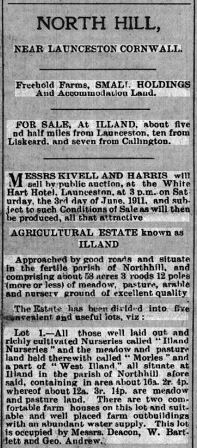


ILLANDEvery day hundreds of people on the B3254 drive past the sign shown above. It is just north of Congdon's Shop and points to a small winding lane that would take the adventurer to the hamlet of Illand. Hardly anybody ever takes this route, but occasionally a farm vehicle turns into the lane and sometimes a car. As the occupants pass through Illand, perhaps on their way towards the hamlet of Newtown, they are rewarded by seeing a working farm, a long established and popular plant nursery and some residential houses. It's all very bucolic and representative of this part of North Hill parish and the surrounding area, largely unchanged for many years. The buildings that make up Illand are largely built from local stone and have stood for centuries. The image to the right (click on it for a larger view) shows the ruin of a mediaeval building in Illand. At the time of Domesday Illand fell under the control of Tavistock Abbey having been acquired by Abbot Sihtric before the Norman invasion. Robert, Count of Mortain and half brother to King William I, is reported to have "helped himself to Boyton, Trebeigh, Illand and Trewenta". Back in the mists of time this small place was divided into two tenements named West Illand and East Illand and these titles were in use in the late 18th century. The farm and many surrounding fields formed West Illand. The nursery was part of East Illand. At one time Illand's tenements were owned by the Peter family. The nurseries are currently run by Ken and Dave Roberts. They have been collecting information about the Peter family who lived at Illand and the following history and anecdotes have been largely derived from that source. Illand was one of the centres of Methodism in the area and according to John Peter (probably the John born in 1696 and died in 1778), John Wesley himself preached at Illand. The part that the Peter family of Illand played in the development of Methodism is evidenced by the entry in "Truly Rural" by Herbert Bolitho on page 38 that cites Richard Peter and his son Samuel. Illand was described by Richard Peter, the historian, in the early 1800s as follows; it may help the reader to refer to the tithe map extract below: "First on the east my father's farmhouse (East Illand) with two dwelling houses for labourers inside his courtlage and another with its sawpit and small yard for a carpenter behind the farmhouse. The dates in square brackets have been added to help the reader gain a better grasp of the time context. Henry Maunder (1764-1844) had at least 14 children and one of them was strangely named Tabitha Tithe Thirza Maunder.Richard Peter continues: "Almost adjoining the Maunders' house was Elizabeth Moylton's house. Here dwelt Old Mrs Molly Perkins the village schoolmistress of whom I learnt my letters and the Church catechism. Later it was occupied by Mr William Peter, another tenant of my eldest son. A little further west and across the road was the farmhouse of Mr John Peter, West Illand, with its surroundings of mowhay, yard and outbuildings. Between these and the outbuildings of Mr John, on the same northern side of the highway, was the open village playground. Need I say here, especially on summer evenings, I spent hundreds of joyous hours, and here, seated on a log of wood often made unmelodious noises on my fife, or keyed flute." Richard Peter's description of an Accident in the Pound House "There were nearly five acres of orchard on East Illand and my father had a machine erected in the Pound House for bringing apples. The machine consisted of an upright shaft supporting a horizontal cogged wheel. Into the shaft was thrust an arm of wood to which a horse, the motive power, was attached. As the cogged wheel circulated it set in rapid action two cylinders with sunk knives in them. These cylinders revolved in opposite directions & met each other, catching and lacerating and crushing the apples which fell on them. Sometimes a large apple would queer the works and someone had to remove it. "On one occasion I was controlling the flow of apples and also in control of the horse. This time it was my pony. I unfortunately caught 2 fingers in the knives but was able to stop my pony at once so saved the residue of my right hand. The middle finger was crushed to the first joint and the fourth finger entirely severed except that the skin held the divided part dangling. My father came and released me and then put my hand in a plaster and bandaged the hand. Later I was taken to Dr. Hender of Callington (my mother's cousin) 7 miles away but he did not disturb the plaster or bandage which were left intact until the wounds healed. The scars and disfigurement never disappeared. I was 11 years of age at the time." More of Richard Peter's remembrances can be seen on the Peter family page. The Peter family retained ownership of the farm at Illand until the mid 1950s when Claude Peter sold it to Ernest Parsons. Ernest was the father of Alan Parsons who lives at the farm today. The farm, of almost 300 acres, is now run by Alan's son, Adrian. We are grateful to Alan for sharing is remembrances with us and who has some special memories. He recalls, for instance, that the farm had a well in the lower side of the yard that never ran dry even if there had been little rain and the surrounding lands were parched. Alan has told us that on the farm is a rare variety of apple tree known as "Hockin's Green Apple" named after the earlier occupiers of the farm. |
A report on a visit made to Illand by The Tamar Dowsers.
ILLAND NURSERIES - up to 1939 - featuring the Peter, Hocking and Lea families |
|
|
|
These two advertisements in the Cornish and Devon Post from February 1879 and September 1881 tell us of a rapid change of ownership of Illand Nursery and prompt questions regarding other owners, the age of the nursery and what it produced. |
|
The earliest document showing a plant nursery at Illand is the 1840 Tithe Apportionment Book for North Hill and its accompanying map. From this we can conclude that the nursery was well established by that date. In his will dated 1766 John Peter who was the then owner (albeit on a long lease as explained below) does not mention a nursery. The tenement of East Illand, of which the nursery was a part, passed down through Peter family. |
|
Below are extracts from the 1841 census showing the Spry brothers, shown as agricultural labourers, on the left and the Peter family on the right. Following the enumerator's route and matching this with the Tithe Map, it is possible that John Peter the younger lived in the residence on plot #172, his father in the residence on plot #248 and the Spry brothers on #162 or #161. There is no mention here of the nursery or nurserymen, nor is the Hocking family mentioned in Illand, as might be expected from the advertisements above. (Click for a larger image). |
Three advertisements for the sale of Illand Nurseries |
||
 |
 |
 |
Cornish & Devon Post |
Cornish & Devon Post |
Cornish & Devon Post |

It has been reported that "all the trees and hedges in [the area of West Castick Farm] came from Illand at the end of the last century".